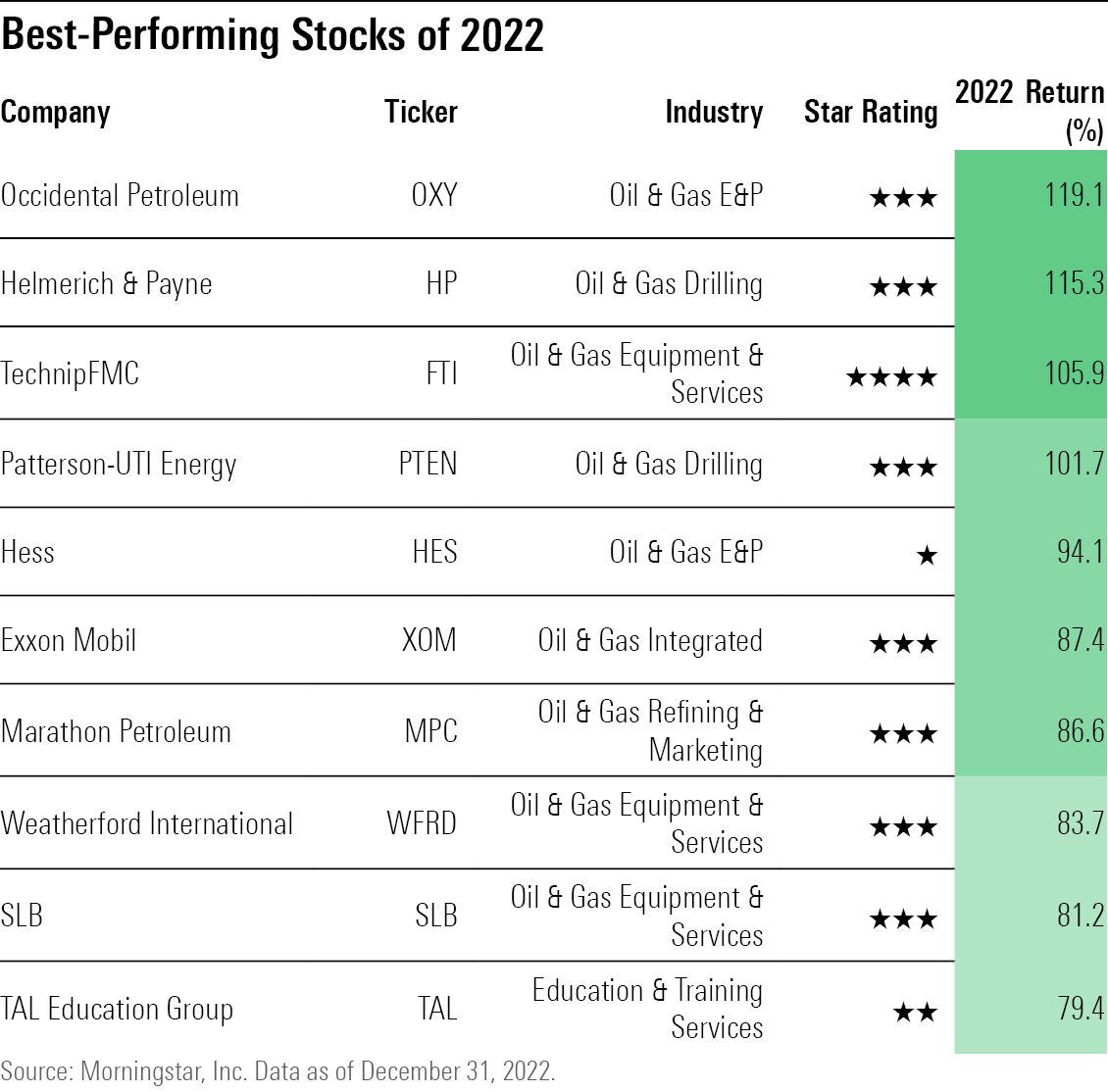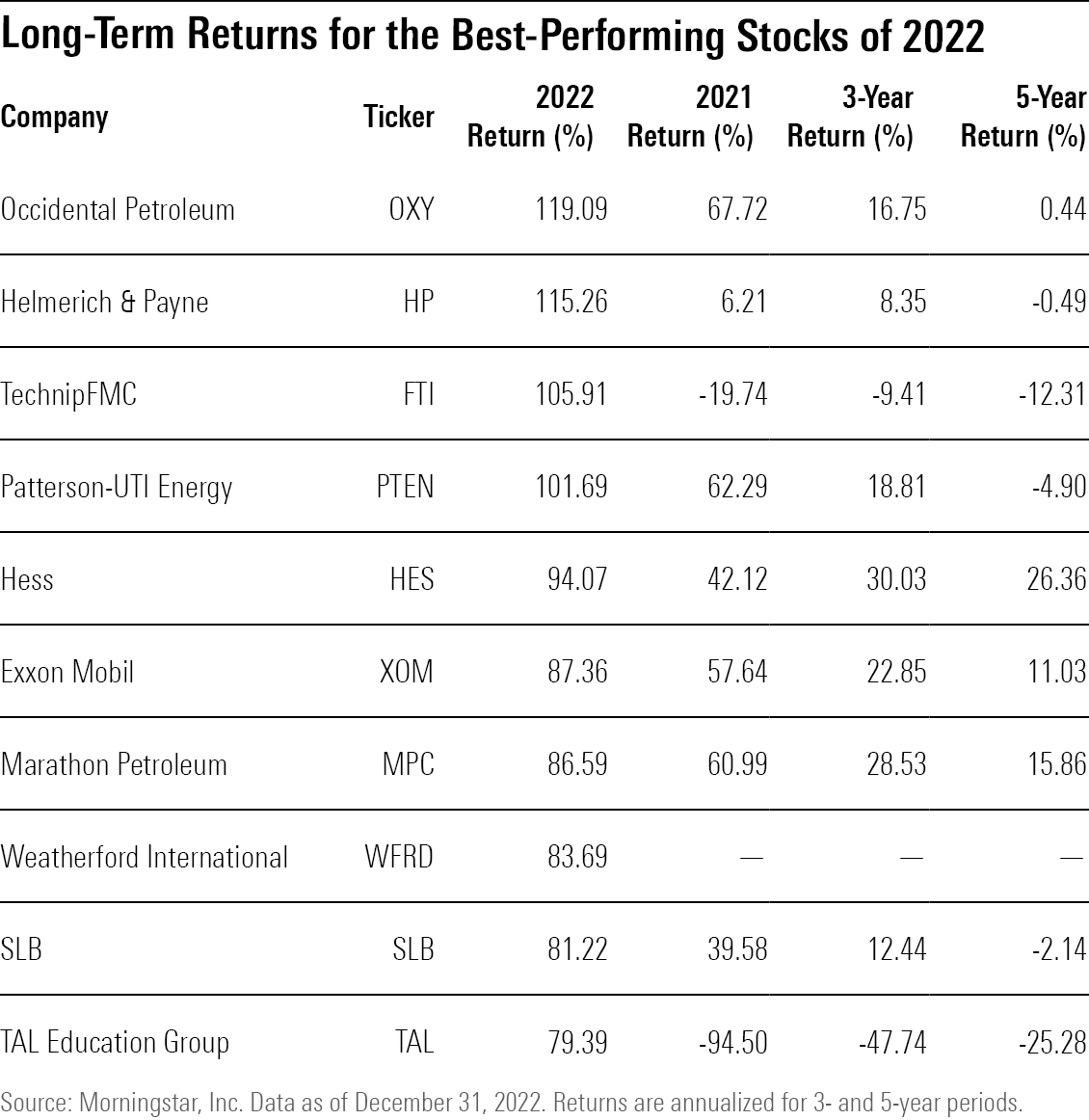Morningstar’s Best- and Worst-Performing Stocks: 2022
Chinese stocks rebound, energy stocks such as Occidental surge, while Farfetch and other internet retailers plunge.

The bear market for stocks produced some significant losses on individual stocks, but 2022 also saw some stocks that were big winners among the names covered by Morningstar’s stock analysts.
That was especially the case among Chinese stocks that rebounded from hefty losses in 2021, and energy stocks that surged on the back of rising oil prices.
Among the worst-performing names are a handful of internet retail companies as the market punished both consumer cyclical and technology shares.
Of the 847 U.S.-listed stocks covered by Morningstar analysts, 237, or 28%, rose and 610, or 72%, fell. Of those, 369 stocks declined by 20% or more. In 2021, only 64 stocks fell that much. Most of the worst-performing stocks were those in the technology, communication services, or consumer cyclical sectors, which are among the most sensitive to macroeconomic changes.
Fewer stocks also posted solid gains this year, with only 105 of the stocks covered by our analysts posting a gain of 20% or more. In 2021, 435 stocks jumped by that much.
Which Stocks Outperformed in 2022?
Energy stocks stole the show in 2022, with all but one of the top 10 best-performing stocks of 2022 in Morningstar’s U.S.-listed coverage coming from the sector.

The energy sector is highly correlated to the performance of oil and gas prices. While oil prices actually declined 35% from their $123.64 high in March, they still remain around $80 a barrel. The last time prices were this high before the COVID pandemic was in October 2014.
Exploration and production companies—or E&P for short—were among the best-performing stocks within the sector. These companies are responsible for extracting oil and gas, and as a result, are the most sensitive to oil prices compared with the rest of the supply chain, says David Meats, Morningstar’s director of equity research for energy and utilities.
The best-performing energy stock was the E&P firm Occidental Petroleum (OXY), which surged 119.1%, its highest annual return since 1979 when it rallied 72.2%. Hess (HES) which rallied 94.1%, and Antero Resources (AR), up 77.1%, were among the best performers.
Investors’ enthusiasm for E&P firms was also fanned by their shift in attitude toward being more financially disciplined, according to Meats. “E&Ps were long demonized by investors for overspending and growing recklessly,” he says. “But firms eventually realized that investors want disciplined investing, with surplus cash returned to shareholders rather than plowed back into drilling.”
At the same time, E&P firms ramped up production to better capture higher oil prices, although at a much slower pace than they have historically, according to Meats and his team. The average number of oil/gas drilling rigs added per dollar increase in oil price in 2022 was approximately 10 rigs, that’s less than half the average of 23 rigs per dollar between 2000 and 2019 when energy companies were “growing recklessly.”
The high price of oil and growth in oil production capacity—albeit at a tamer pace—nevertheless provided a tailwind for the rest of the oil market, such as oil and gas equipment providers like TechnipFMC (FTI) and Patterson-UTI Energy (PTEN), which also rank in the top 10 performers of 2022.
The 10th best-performing stock of 2022 was the China-based education-services company Tal Education Group (TAL), which after being ranked the worst-performing stock of 2021, made a complete turnaround and rallied 79.4% during the year. Competitor New Oriental Education & Technology Group (EDU) also reversed its 2021 losses and gained 65.8% during 2022. Still, despite those gains, Tal Education is down 85.4% from the start of 2020, and New Oriental Education & Technology Group is down 71.3%.
Driving the turnaround in 2022 was a shift in strategy for both companies. After China’s Ministry of Education banned for-profit tutoring services for K-9 schooling, both companies pivoted their businesses to find new lines of revenue, such as nonacademic education services—which involves tutoring in topics such as computer programming, science, and creativity—or developing new technology-based learning solutions.

Which Stocks Underperformed in 2022?
The worst-performing stock of 2022 was Chinese pharmaceutical company I-Mab Biopharma (IMAB), which lost 91.2%. Shares fell at the start of the year on concerns that the company’s drug lemzo would not be approved by the U.S. Food and Drug Administration. These fears were spurred on by the FDA’s rejection of another drug, plinabulin, which was developed by a China-based subsidiary of BeyondSpring Pharmaceuticals (BYSI).

I-Mab again ran into trouble after AbbVie (ABBV) discontinued research into a combination treatment for myelodysplastic syndromes, or MDS, with I-Mab’s drug lemzo. “Although I-Mab will continue to develop lemzo in China for MDS and AML [acute myeloid leukemia], the market potential is much smaller now that AbbVie will no longer move forward with it in the United States,” says Morningstar’s Jay Lee, senior equity analyst.
Internet and some traditional retail stocks also suffered in 2022, as inflation and changing consumer habits broadly hit the industry. Worst off were The RealReal (REAL) and Farfetch (FTCH).
The RealReal faces declining sales on top of a major debt repayment of $172.5 million looming in 2025—more than half the firm’s recent liquidity level. Shares were down 89.2% in 2022.
Investors sold off on shares of Farfetch, which were down 85.9%, following three cuts to the company’s outlook by management in 2022, raising concerns over the company’s near-term performance. As of Dec. 1, the firm set targets to grow the gross merchandise value on their platform to $10 billion by 2025, which would imply an 8%-10% annual growth rate, far below the 38% compounded annual growth the company had in the past three years, says Jelena Sokolova, a senior equity analyst at Morningstar.
Other major decliners in retail included Wayfair (W), down 82.7%, and Bed Bath & Beyond (BBBY), which fell 82.8%.
Shares of Coinbase Global (COIN) collapsed 86%, following the cryptocurrency meltdown, with bitcoin down roughly 65% for the year and negative sentiment exacerbated by the collapse of FTX.
Intensifying macroeconomic pressures in the form of rising interest rates led to a bloodbath for many technology and communication services stocks early in the year. At the end of it, stocks such as Twilio (TWLO) and Roku (ROKU) had more than 80% of their equity value shaved off.

Correction: Jan. 4, 2023: A previous version of this article misnamed the U.S. Food and Drug Administration.
The author or authors do not own shares in any securities mentioned in this article. Find out about Morningstar’s editorial policies.


/cloudfront-us-east-1.images.arcpublishing.com/morningstar/54RIEB5NTVG73FNGCTH6TGQMWU.png)
/cloudfront-us-east-1.images.arcpublishing.com/morningstar/ZYJVMA34ANHZZDT5KOPPUVFLPE.png)
/cloudfront-us-east-1.images.arcpublishing.com/morningstar/MNPB4CP64NCNLA3MTELE3ISLRY.jpg)